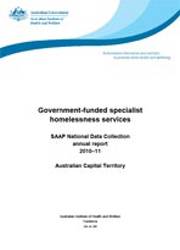Summary
This publication is one of eight state and territory supplements that accompany the 2010–11 annual report on the use of government-funded specialist homelessness services in Australia (AIHW 2011a). Information to aid readers in interpreting the data is presented in the national report and appendixes (AIHW 2011i).
In line with the national picture, service users in the Australian Capital Territory:
- were mostly female
- were often relatively young
- were mostly non-Indigenous, however, Aboriginal and Torres Strait Islander people were over-represented relative to their population size
- commonly sought support because of issues in their interpersonal relationships, such as the breakdown of a relationship with a family member, spouse or partner
- immediately on exit from support, were most often living in a house or flat; were not employed; and had a government pension or benefit as their main source of income.
Some other points of interest in the Australian Capital Territory were:
- the rate of use of specialist homelessness services was slightly higher than the national average
- the age profile of clients was younger than in other jurisdictions, but the age of clients has increased in recent years
- seeking support primarily because of the breakdown of a family or other relationship was the highest nationally
- the lengths of support and accommodation were the longest nationally
- clients exited support to live in public or community housing in relatively high levels
- clients were more often employed both immediately before and after support than those in other jurisdictions.



